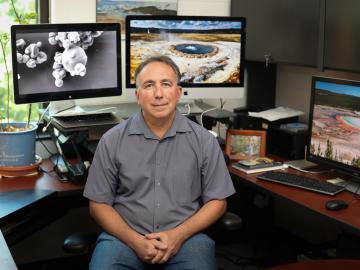
Filter News
Area of Research
- Advanced Manufacturing (6)
- Biology and Environment (89)
- Biology and Soft Matter (1)
- Computational Biology (1)
- Computational Engineering (1)
- Computer Science (1)
- Electricity and Smart Grid (1)
- Energy Science (66)
- Functional Materials for Energy (1)
- Fusion and Fission (9)
- Fusion Energy (6)
- Isotopes (23)
- Materials (48)
- Materials for Computing (6)
- Mathematics (1)
- National Security (9)
- Neutron Science (87)
- Nuclear Science and Technology (17)
- Nuclear Systems Modeling, Simulation and Validation (1)
- Supercomputing (32)
News Type
News Topics
- (-) Advanced Reactors (30)
- (-) Clean Water (30)
- (-) Composites (25)
- (-) Environment (178)
- (-) Isotopes (46)
- (-) Neutron Science (122)
- (-) Space Exploration (24)
- 3-D Printing/Advanced Manufacturing (106)
- Artificial Intelligence (100)
- Big Data (66)
- Bioenergy (90)
- Biology (106)
- Biomedical (57)
- Biotechnology (28)
- Buildings (57)
- Chemical Sciences (59)
- Computer Science (169)
- Coronavirus (34)
- Critical Materials (18)
- Cybersecurity (23)
- Education (2)
- Emergency (4)
- Energy Storage (79)
- Exascale Computing (54)
- Fossil Energy (7)
- Frontier (48)
- Fusion (56)
- Grid (57)
- High-Performance Computing (104)
- Hydropower (12)
- Irradiation (3)
- ITER (8)
- Machine Learning (53)
- Materials (118)
- Materials Science (109)
- Mathematics (11)
- Mercury (10)
- Microelectronics (3)
- Microscopy (42)
- Molten Salt (8)
- Nanotechnology (41)
- National Security (70)
- Nuclear Energy (98)
- Partnerships (43)
- Physics (44)
- Polymers (23)
- Quantum Computing (41)
- Quantum Science (63)
- Security (20)
- Simulation (55)
- Software (1)
- Statistics (3)
- Summit (50)
- Transportation (77)
Media Contacts

Oak Ridge National Laboratory researchers working on neutron imaging capabilities for nuclear materials have developed a process for seeing the inside of uranium particles – without cutting them open.

Mircea Podar, Distinguished Staff Scientist and Leader of the Systems Genetics Group in the Biosciences Division at Oak Ridge National Laboratory, has been elected fellow of the American Academy of Microbiology.

Jitendra Kumar, a researcher at the Department of Energy’s Oak Ridge National Laboratory, has been elevated to the grade of senior member of the Institute of Electrical and Electronics Engineers (IEEE).

A software package, 10 years in the making, that can predict the behavior of nuclear reactors’ cores with stunning accuracy has been licensed commercially for the first time.

A versatile class of flexible, protein-like polymers could significantly advance future drug delivery methods. But first, scientists have to develop a reliable process for tailoring these polymers into shapes that can effectively transport medicines throughout the human body.

Biological membranes, such as the “walls” of most types of living cells, primarily consist of a double layer of lipids, or “lipid bilayer,” that forms the structure, and a variety of embedded and attached proteins with highly specialized functions, including proteins that rapidly and selectively transport ions and molecules in and out of the cell.

Each year, approximately 6 billion gallons of fuel are wasted as vehicles wait at stop lights or sit in dense traffic with engines idling, according to US Department of Energy estimates.

A novel approach developed by scientists at ORNL can scan massive datasets of large-scale satellite images to more accurately map infrastructure – such as buildings and roads – in hours versus days.

Researchers have developed a new process that could make it much cheaper to produce biofuels such as ethanol from plant waste and reduce reliance on fossil fuels.

Nuclear scientists at Oak Ridge National Laboratory have established a Nuclear Quality Assurance-1 program for a software product designed to simulate today’s commercial nuclear reactors – removing a significant barrier for industry adoption of the technology.


